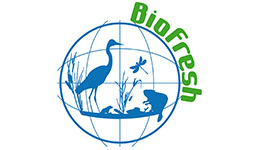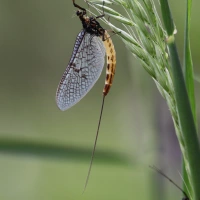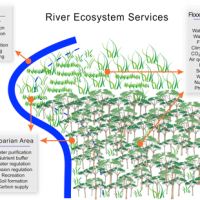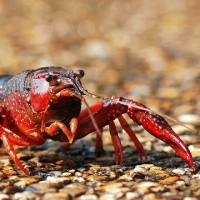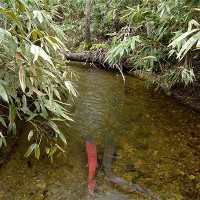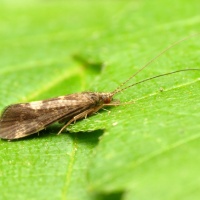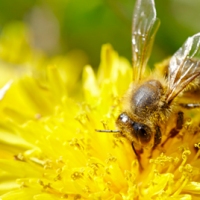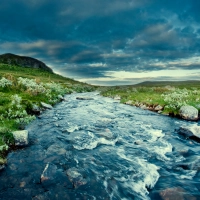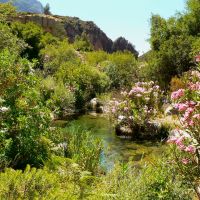Seeking freshwater pandas: the ‘flagship umbrella species’ approach

European sturgeon (Acipenser sturio), a potential ‘flagship’ species which is threatened by pollution and habitat fragmentation. Image © A. Hartl
Freshwaters are amongst the most heavily modified global ecosystems, and the rich biodiversity they support is at a disproportionate risk of extinction. Conservation and restoration efforts aimed at protecting and improving freshwater habitats are being carried out across the world, but aquatic plants and animals remain amongst the most threatened components of global biodiversity.
One reason for this shortfall may be the lack of visibility – both literally and metaphorically – for freshwater life. Freshwaters may be murky, fast-flowing, deep, cold, ice-covered or turbulent, and the biodiversity they support can often be camouflaged, elusive and difficult to spot. The rich webs of animal and plant life below the surface of freshwaters are not as immediately perceptible as a wildflower meadow or a woodland, say. And, as the ‘shifting baseline’ concept illustrates, public and political perception of the health and diversity of ecosystems can significantly influence the support (or lack thereof) afforded to conservation and restoration schemes.
The identification of flagship species for aquatic ecosystems – so-called ‘freshwater pandas’ – may help bring threatened freshwater biodiversity ‘to life’ and increase awareness of, and support for, conservation measures, according to a new open-access study published in Conservation Biology. Flagship species were defined in 2000 by conservationists Nigel Leader-Williams and Holly Dublin as “popular charismatic species that serve as symbols and rallying points to stimulate conservation awareness and action.”
According to Dr Gregor Kalinkat from the Leibniz-Institute of Freshwater Ecology and Inland Fisheries (IGB) in Berlin, the lead author of the new study, a suite of over 60 potentially suitable freshwater ‘umbrella flagship species’ may help strengthen and target existing – but often inadequate – conservation efforts.

The yellow-winged darter (Sympetrum flaveolum), a highly ‘charismatic’ aquatic insect. Image: © André Karwath (CC BY-SA 2.5)
Flagship and umbrella species
Flagship species are typically ‘charismatic’ species which enthuse, enchant and intrigue public and political audiences with the natural world. Environmental geographer Jamie Lorimer provides a helpful typology of such non-human charisma, which may be ecological (the environmental ‘detectability’ of an organism, e.g. through a call), aesthetic (its sensory impact: e.g. cuddly, fierce, curious) and/or corporeal (its emotive impact; or, how it makes us feel). For Lorimer, these aspects of non-human charisma are combined designating flagship species for conservation. For example the human empathy and care often sparked by a panda’s ‘teddy bear’ looks and precarious life habits (surviving on nutrient-poor bamboo) has long been mobilised by the World Wildlife Fund as a flagship logo to leverage funding and support, both for the conservation of the forests on which it survives, and for threatened ecosystems worldwide.
In other words, the charisma (and in the panda’s case, this might include the simple black and white replicability of its form as a logo in a pre-digital age) of flagship species may be mobilised to help strengthen conservation efforts for other less charismatic or visible species across wider ecosystems, whether locally or globally. In this way, the flagship concept has resonances with the ‘umbrella species’ approach to conservation which aims to protect ecosystems through conservation measures targeted at a small number of ‘keystone’ species which also have ecological benefits to the wider ecosystem. However, the flagship species approach has historically been used to mobilise public awareness of nature, rather than to specifically target ‘umbrella’ ecological interactions.

The arapaima (Arapaima gigas), a ‘flagship’ fish native to the rivers and seasonal pools of Amazonia. Image: © T. Voekler (CC BY-SA 3.0)
Identifying ‘freshwater pandas’
The research team behind the new Conservation Biology study call for the established ‘flagship’ and ‘umbrella’ species concepts to be combined to define a new set of ‘flagship umbrella species’. According to the authors, such species have the potential to both raise public and political awareness of imperiled species and ecosystems, and to provide a focus-point for conservation efforts which will ‘trickle down’ and benefit wider ecological communities.
They identify over 60 potentially suitable freshwater flagship umbrella species, based on their “potential to attract public attention and funding for conservation programs as well as [their] potential to protect co-occurring biodiversity in all types of freshwater habitats.” The species – which were selected on the basis of their ‘flagship’ potential as identified in existing conservation literature – are extremely diverse and distributed across the world.
They include algae, molluscs (such as the freshwater pearl mussel), spiders endemic to peat bogs, crustaceans (such as the fairy shrimp), insects (including dragonflies and damselflies), a wide array of fish species (including sturgeon, stingray, sharks, salmonids, catfish and cod), amphibians (various frogs, toads and newts), reptiles (including turtles, crocodiles and alligators), birds (particularly cranes, pelicans and storks), and mammals (including otters, dolphins, porpoises and beavers) (see the full list here).
Some notable examples include: the baiji, a functionally extinct species of freshwater dolphin formerly found only in the Yangtze River in China; the European sturgeon, a migratory fish impacted by the fragmentation and pollution of large river basins such as the Danube; the Siberian crane a critically endangered bird with migration routes across the wetlands of Central and East Asia; and the freshwater pearl mussel, a mollusc threatened by water pollution and over-harvesting.

A flock of Siberian crane (Leucogeranus leucogeranus). Image: © Crane Wu
How useful might ‘freshwater pandas’ be, and where?
It could be argued that the idea of promoting freshwater flagship species is not new: after all, the image of the Atlantic salmon is regularly used to promote river restoration efforts across Europe, and the Eurasian beaver is proving an effective (if controversial) flagship species for public debates over the forms and functions of ‘rewilded’ river catchments in the UK. Similarly, a recent study by Nishikant Gupta and colleagues describes the ‘charismatic’ ability of the golden mahseer, a river fish endemic to northern India, in bringing together river users to support conservation of its habitat. In this context, a key question is: can flagship and umbrella species be (more) useful in supporting freshwater conservation efforts, and if so, how?
A 2011 review of the conservation literature around flagship and umbrella species by environmental geographer Maan Barua yielded three important insights: first, that existing flagship and umbrella species are predominantly mammals; second, that everyday language plays a vital role in communicating environmental issues through flagships; and third, that metaphors are important in shaping public understandings and responses to conservation messages. Barua discusses how ‘mobilising metaphors’ is thus a key consideration in selecting flagship species: in other words, how might different ‘charismatic’ natures (e.g. curiosity, fragility, beauty or ugliness) be aligned to a range of environmental issues to be communicated to wider public audiences; what conservation ‘work’ might they do in the world when circulating as metaphors and abstractions?
Whilst the authors of the Conservation Biology study don’t explicitly address the same issues for flagship species selection, similar considerations circle their work. As ever, scale matters: at what scales (local, regional, global) are flagship species likely to find an audience, and what conservation messages will these audiences be receptive to? Through what channels will flagship representations ‘travel’ (e.g. social media, television), and at what scale is any resulting funding or political influence likely to feedback to influence conservation outcomes? These are big questions which require interdisciplinary research and practice if the use of freshwater flagship species is to have positive conservation outcomes.

Freshwater pearl mussels (Margaritifera margaritifera). Image: © Joel Berglund (CC BY-SA 3.0)
The promise of new data to support ‘flagship umbrella species’
In this context, the new Conservation Biology study outlines an approach to strengthen established ‘flagship’ and ‘umbrella’ species approaches by combining them, with the aid of new data gathering techniques. In other words, the authors envision the potential of ‘flagship umbrella species’ which can both leverage public support and awareness for conservation, and provide an ecological ‘umbrella’ for conservation measures which indirectly benefit wider ecological communities.
For example, molecular methods such as environmental DNA are improving swiftly, allowing researchers to determine the existence of fish or amphibian species from simple water samples, which in the past needed to be collected painstakingly by hand or using nets. Such methods offer the potential of developing our understanding of under-researched or ‘overlooked’ (as the authors put it) freshwater biodiversity across the world, and for targeted conservation measures to be developed, implemented and communicated.
The study’s lead author Gregor Kalinkat outlines the potential of new approaches, “To date, a disproportionately large amount of research and scientific data material has been collected on land and for marine species. In order to protect freshwater species, we are in urgent need of more comprehensive data, which can be collected both cost-effectively and extensively using innovative methods.”
The freshwater ‘flagship umbrella species’ approach is – like most conservation initiatives – inherently interdisciplinary: drawing together insights from the social sciences and humanities such as charisma and issue-framing, with cutting-edge scientific methods such as environmental DNA. Whether through ‘flagships’ or ‘umbrellas’, what is clear is that increasingly threatened freshwater ecosystems are in need of new beacons for conservation research, action and hope.


